The Collapse of Titanium C-Column due to Thermal Compression
Abstract
1. Introduction
2. Problem Description
2.1. The Study Object
2.2. Material Data
2.3. Finite Element (FE) Model
3. Results
3.1. Buckling Forces
3.2. Compression in Ambient Temperature
3.3. Thermal Compression
4. Summary
- Both mechanical properties and load-carrying capacity of titanium columns are very sensitive to temperature rise although the titanium is resistant moderately to high temperature. The increase of temperature increment by 175 K referring to ambient temperature causes the load peak during compression to decrease almost by a half. Moreover, as was observed, titanium columns under load in elevated temperatures became slightly mild which might bring additional local deformation diminishing the general load-carrying capacity of columns.
- The assumption of stable mechanical properties of titanium (temperature-independent) in numerical simulations does not allow proper load-carrying capacity to be achieved which can be compared to experiment. In the case of consideration of stable mechanical properties of titanium, obtained load peaks for higher temperatures are almost the same.
- Regarding buckling loads, considered boundary conditions S_3 and S_4 (Temp) gave the highest critical forces (almost 10 kN). The visible clues of appearing half-waves in columns during experiments were noticed to be also in a range of loads of 8–10 kN. Moreover, estimated critical loads were circa two times smaller than the load-carrying capacity of the column in ambient temperature.
- The maximum loads obtained numerically were pretty close to experimental ones although the discrepancies amount up to 40%, at most (for temperature increment 150 K). It can be explained that the analysed phenomenon of full behaviour of thin-walled columns in a thermal field seems to be very complex. Firstly, studied columns could be imperfect resulting from a tolerance of thicknesses, other dimensions and the whole shape. Secondly, mechanical properties of titanium are very dependent on temperature changes. Thirdly, the steel plates (upper and lower) with made channels (grooves) holding the columns possess a proper thermal expansions coefficient, which is slightly different from the thermal expansion coefficient of titanium. Therefore, during compression the conditions of supports could continuously change. Furthermore, in numerical simulations, some simplifications (linear interpolations of one-directional tensile curves for adequate temperature) were applied to solve the problem in an approximate way.
- The curve of force vs. shortening of the column for ambient temperature for numerical model is comparable in reference to experimental curves but in the case of numerical model, the obtained range of shortening in column was shorter. This could result from the fact that numerical model was assumed as perfect what brings locally to concentrations of maximum plastic stresses after the load peak. Therefore, the effect could cause a drop of load to follow violently.
- By comparing DICAS and FEM maps, the modes of deformation in all phases seem usually to be alike. Both greater discrepancies and completely different modes can be observed as well. It can be clarified that each column under compression in elevated temperature can deform in different way.
- The appearance of mechanisms (large deformations) of the columns during the last stage of complete damage occurred in the vicinity of that of support (especially in the case of numerical results). In the case of some samples, failure of the columns occurred in the middle (dT = 25 K, dT = 50 K, dT = 125 K).
Author Contributions
Funding
Acknowledgments
Conflicts of Interest
References
- Guo, R.; Liu, B.; Xu, R.; Cao, Y.; Qiu, J.; Chen, F.; Yan, Z.; Liu, Y. Microstructure and mechanical properties of powder metallurgy high temperature titanium alloy with high Si content. Mater. Sci. Eng. A 2020, 777, 138993. [Google Scholar] [CrossRef]
- Bodunrin, M.; Chown, L.H.; Omotoyinbo, J.A. Development of low-cost titanium alloys: A chronicle of challenges and opportunities. Mater. Today Proc. 2020. [Google Scholar] [CrossRef]
- Koizumi, H.; Takeuchi, Y.; Imai, H.; Kawai, T.; Yoneyama, T. Application of titanium and titanium alloys to fixed dental prostheses. J. Prosthodont. Res. 2019, 63, 266–270. [Google Scholar] [CrossRef]
- Zhao, Q.Y.; Yang, F.; Torrens, R.; Bolzoni, L. Comparison of hot deformation behaviour and microstructural evolution for Ti-5Al-5V-5Mo-3Cr alloys prepared by powder metallurgy and ingot metallurgy approaches. Mater. Des. 2019, 169, 107682. [Google Scholar] [CrossRef]
- Su, M.-N.; Zhang, Y.; Young, B. Design of aluminium alloy beams at elevated temperatures. Thin Walled Struct. 2019, 140, 506–515. [Google Scholar] [CrossRef]
- Li, H.-T.; Young, B. Cold-formed high strength steel SHS and RHS beams at elevated temperatures. J. Constr. Steel Res. 2019, 158, 475–485. [Google Scholar] [CrossRef]
- Fang, H.; Chan, T.-M. Axial compressive strength of welded S460 steel columns at elevated temperatures. Thin Walled Struct. 2018, 129, 213–224. [Google Scholar] [CrossRef]
- Fan, S.; Jia, L.; Lyu, X.; Sun, W.; Chen, M.; Zheng, J. Experimental investigation of austenitic stainless steel material at elevated temperatures. Constr. Build. Mater. 2017, 155, 267–285. [Google Scholar] [CrossRef]
- Li, H.-T.; Young, B. Material properties of cold-formed high strength steel at elevated temperatures. Thin Walled Struct. 2017, 115, 289–299. [Google Scholar] [CrossRef]
- Nguyena, P.L.; Vua, X.H.; Ferriera, E. Thermo-mechanical performance of Carbon Fiber Reinforced Polymer (CFRP), with and without fire protection material, under combined elevated temperature and mechanical loading conditions. Compos. Part B Eng. 2019, 169, 164–173. [Google Scholar] [CrossRef]
- Jin, T.; Ha, N.S.; Le, V.T.; Goo, N.S.; Jeon, H.C. Thermal buckling measurement of a laminated composite plate under a uniform temperature distribution using the digital image correlation method. Compos. Struct. 2015, 123, 420–429. [Google Scholar] [CrossRef]
- Jin, T.L.; Ha, N.S.; Goo, N.S. A study of the thermal buckling behavior of a circular aluminum plate using the digital image correlation technique and finite element analysis. Thin Walled Struct. 2014, 77, 187–197. [Google Scholar] [CrossRef]
- Jo, B.; Sagawa, W.; Okamoto, K. Measurement of buckling load for metallic plate columns in severe accident conditions. Nucl. Eng. Des. 2014, 274, 118–128. [Google Scholar] [CrossRef]
- Czechowski, L.; Kędziora, S.; Kołakowski, Z. The Buckling and Post-Buckling of Steel C-Columns in Elevated Temperature. Materials 2020, 13, 74. [Google Scholar] [CrossRef] [PubMed]
- Zhou, F.; Zhang, J.; Song, S.; Yang, D.; Wang, C. Effect of Temperature on Material Properties of Carbon Fiber Reinforced Polymer (CFRP) Tendons: Experiments and Model Assessment. Materials 2019, 12, 1025. [Google Scholar] [CrossRef] [PubMed]
- Khaneghahi, M.H.; Najafabadi, E.P.; Bazli, M.; Oskouei, A.V.; Zhao, X.L. The effect of elevated temperatures on the compressive section capacity of pultruded GFRP profiles. Constr. Build. Mater. 2020, 249, 118725. [Google Scholar] [CrossRef]
- Glassman, J.D.; Gomez, A.; Moreyra Garlock, M.E.; Ricles, J. Mechanical properties of weathering steels at elevated temperatures. J. Constr. Steel Res. 2020, 168, 105996. [Google Scholar] [CrossRef]
- Zhang, Y.; Yang, L.; Lu, W.; Wei, D.; Meng, T.; Gao, S. Microstructure and elevated temperature mechanical properties of IN718 alloy fabricated by laser metal deposition. Mater. Sci. Eng. A 2020, 771, 138580. [Google Scholar] [CrossRef]
- Rokilan, M.; Mahendran, M. Elevated temperature mechanical properties of cold-rolled steel sheets and cold-formed steel sections. J. Constr. Steel Res. 2020. [Google Scholar] [CrossRef]
- Su, M.-N.; Young, B. Material properties of normal and high strength aluminium alloys at elevated temperatures. Thin Walled Struct. 2019, 137, 463–471. [Google Scholar] [CrossRef]
- Xiong, M.-X.; Liew, J.Y.R. Experimental study to differentiate mechanical behaviours of TMCP and QT high strength steel at elevated temperatures. Constr. Build. Mater. 2020, 242, 118105. [Google Scholar] [CrossRef]
- Liang, Y.; Manninen, T.; Zhao, O.; Walport, F.; Gardner, L. Elevated temperature material properties of a new high-chromium austenitic stainless steel. J. Constr. Steel Res. 2019, 152, 261–273. [Google Scholar] [CrossRef]
- Wattanasakulpong, N.; Prusty, G.B.; Kelly, D.W. Thermal buckling and elastic vibration of third-order shear deformable functionally graded beams. Int. J. Mech. Sci. 2011, 53, 734–743. [Google Scholar] [CrossRef]
- Trabelsi, S.; Frikha, A.; Zghal, S.; Dammak, F. Thermal post-buckling analysis of functionally graded material structures using a modified FSDT. Int. J. Mech. Sci. 2018, 144, 74–89. [Google Scholar] [CrossRef]
- Bui, T.Q.; Van Do, T.; Ton, L.H.T.; Doan, D.H.; Tanaka, S.; Pham, D.T.; Nguyen-Van, T.A.; Yu, T.; Hirose, S. On the high temperature mechanical behaviors analysis of heated functionally graded plates using FEM and a new third-order shear deformation plate theory. Compos. Part B Eng. 2016, 92, 218–224. [Google Scholar] [CrossRef]
- Czechowski, L.; Kowal-Michalska, K. Static and dynamic buckling of rectangular functionally graded plates subjected to thermal loading. Strength Mater. 2013, 45, 666–673. [Google Scholar] [CrossRef]
- Javani, M.; Kiani, Y.; Eslami, M.R. Thermal buckling of FG graphene platelet reinforced composite annular sector plates. Thin Walled Struct. 2020, 148, 106589. [Google Scholar] [CrossRef]
- Ansari, R.; Torabi, J.; Hassani, R. Thermal buckling analysis of temperature-dependent FG-CNTRC quadrilateral plates. Comput. Math. Appl. 2019, 77, 1294–1311. [Google Scholar] [CrossRef]
- Devarajan, B.; Kapania, R.K. Thermal buckling of curvilinearly stiffened laminated composite plates with cutouts using isogeometric analysis. Compos. Struct. 2020, 238, 111881. [Google Scholar] [CrossRef]
- Kubiak, T.; Borkowski, Ł.; Wiacek, N. Experimental Investigations of Impact Damage Influence on Behavior of Thin-Walled Composite Beam Subjected to Pure Bending. Materials 2019, 12, 1127. [Google Scholar] [CrossRef]
- Kołakowski, Z.; Teter, A. Load carrying capacity of functionally graded columns with open cross-sections under static compression. Compos. Struct. 2015, 129, 1–7. [Google Scholar] [CrossRef]
- Zaczynska, M.; Kołakowski, Z. The influence of the internal forces of the buckling modes on the load-carrying capacity of composite medium-length beams under bending. Materials 2020, 13, 455. [Google Scholar] [CrossRef] [PubMed]
- Dębski, H.; Jonak, J. Failure analysis of thin-walled composite channel section columns. Compos. Struct. 2015, 132, 567–574. [Google Scholar] [CrossRef]
- Zhu, X.; Xiong, C.; Yin, J.; Yin, D.; Deng, H. Bending Experiment and Mechanical Properties Analysis of Composite Sandwich Laminated Box Beams. Materials 2019, 12, 2959. [Google Scholar] [CrossRef]
- Urbaniak, M.; Teter, A.; Kubiak, T. Influence of boundary conditions on the critical and failure load in the GFPR channel cross-section columns subjected to compression. Compos. Struct. 2015, 134, 199–208. [Google Scholar] [CrossRef]
- Dębski, H.; Kubiak, T.; Teter, A. Buckling and postbuckling behaviour of thin-walled composite channel section column. Compos. Struct. 2013, 100, 195–204. [Google Scholar] [CrossRef]
- Yang, J.; Shen, H.S. Nonlinear bending analysis of shear deformable functionally graded plates subjected to thermo-mechanical loads under various boundary conditions. Compos. Part B Eng. 2003, 34, 103–115. [Google Scholar] [CrossRef]
- Kopecki, T.; Mazurek, P.; Lis, T. Experimental and Numerical Analysis of a Composite Thin-Walled Cylindrical Structures with Different Variants of Stiffeners, Subjected to Torsion. Materials 2019, 12, 3230. [Google Scholar] [CrossRef]
- Bhardwaj, G.; Singh, I.V.; Mishra, B.K.; Bui, Q.T. Numerical simulation of functionally graded cracked plates using NURBS based XIGA under different loads and boundary conditions. Compos. Struct. 2015, 126, 347–359. [Google Scholar] [CrossRef]
- Kahn-Jetter, Z.L.; Chu, T.C. Three-dimensional displacement measurements using digital image correlation and photogrammic analysis. Exp. Mech. 1990, 30, 10–16. [Google Scholar] [CrossRef]
- MSC Software. User′s Guide. MSC FEA® 2010 R1; MSC Software Inc.: Newport Beach, CA, USA, 2010. [Google Scholar]

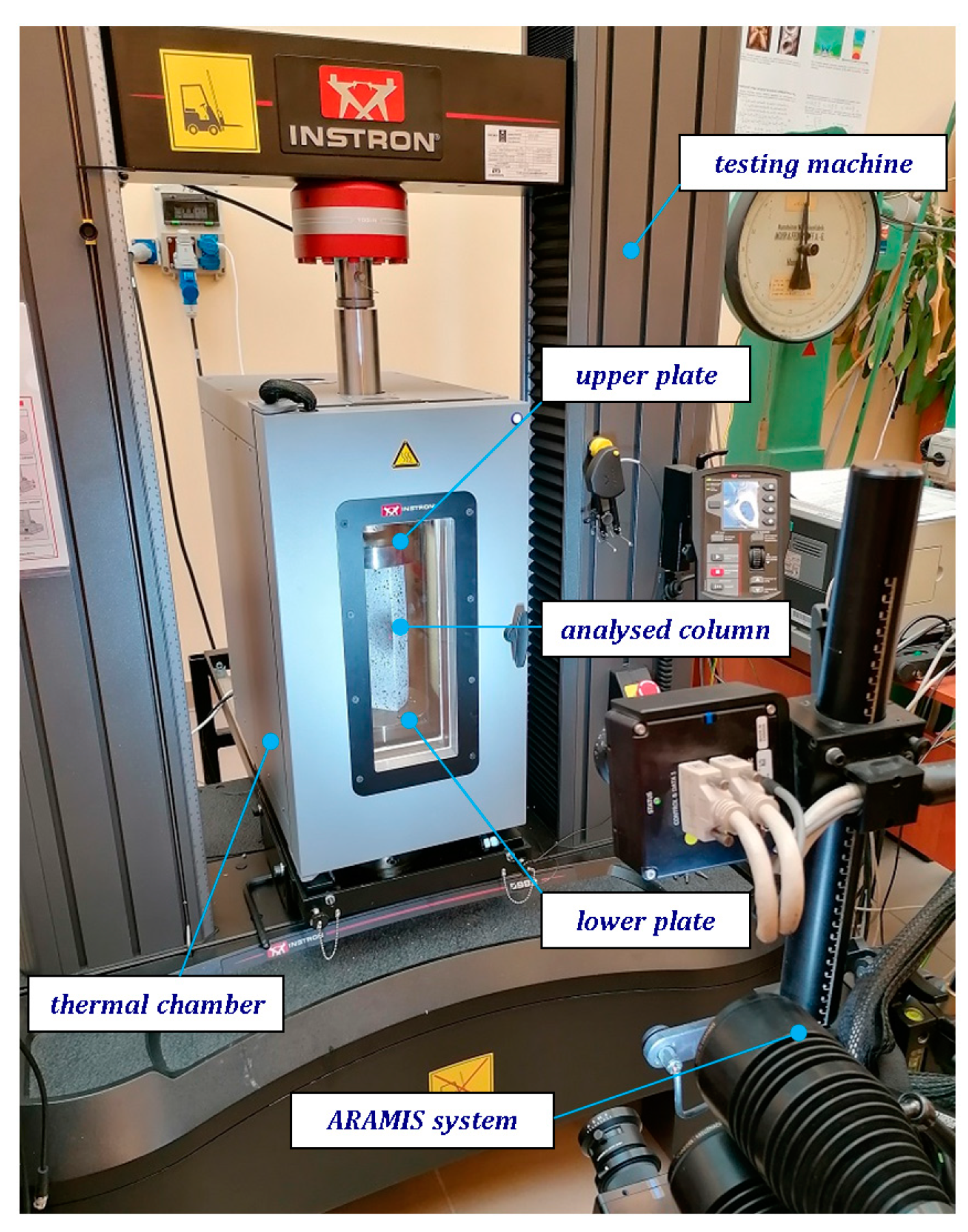
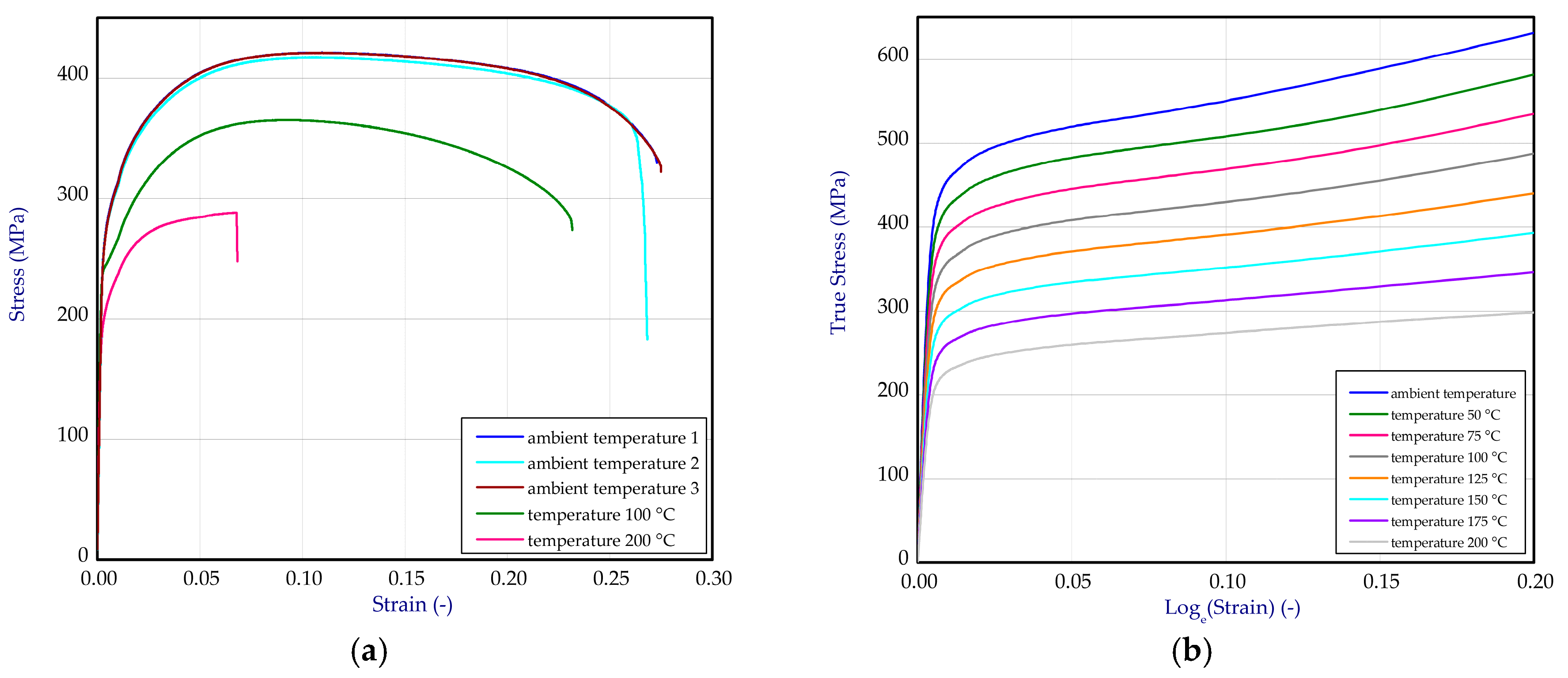
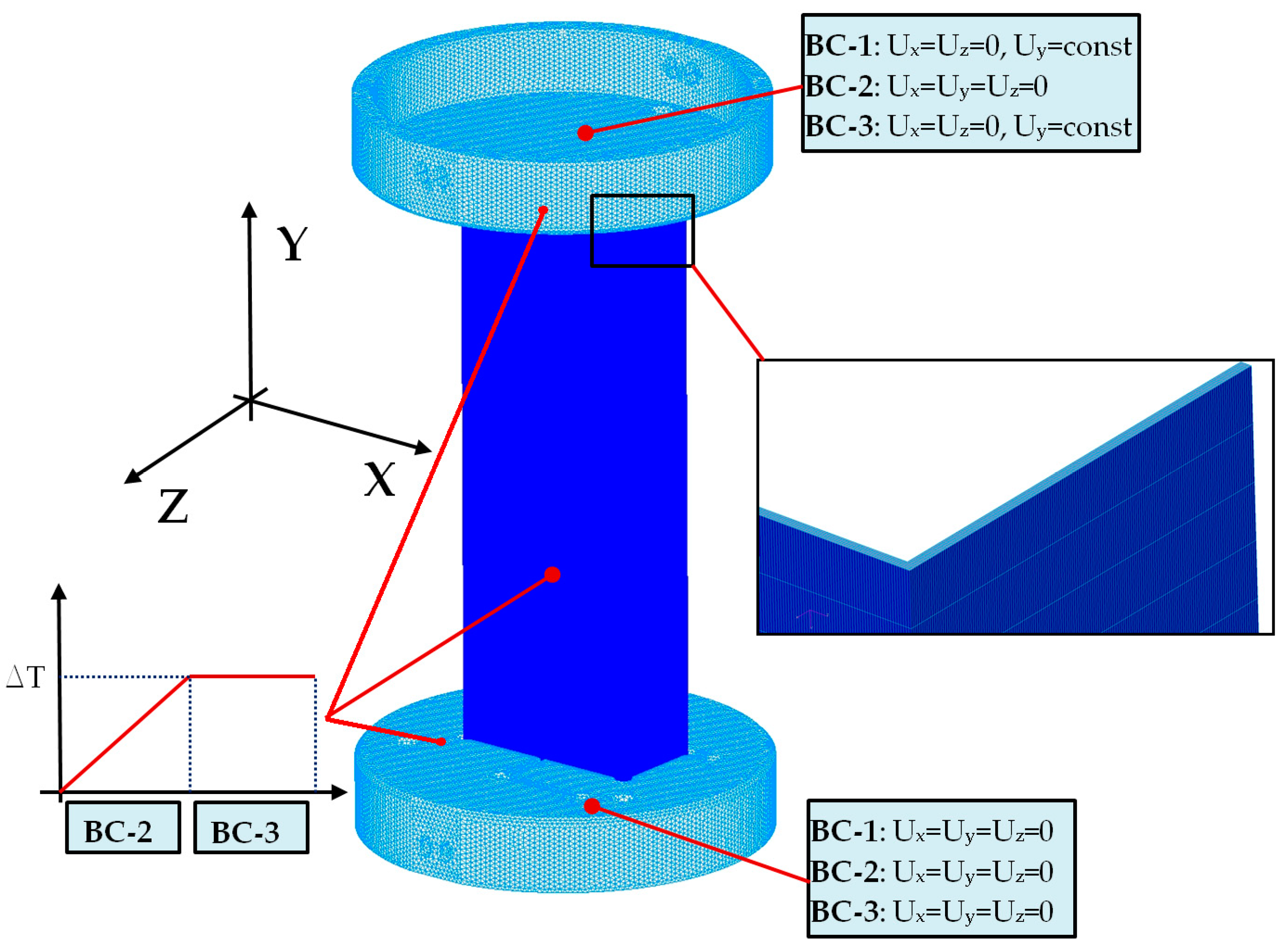
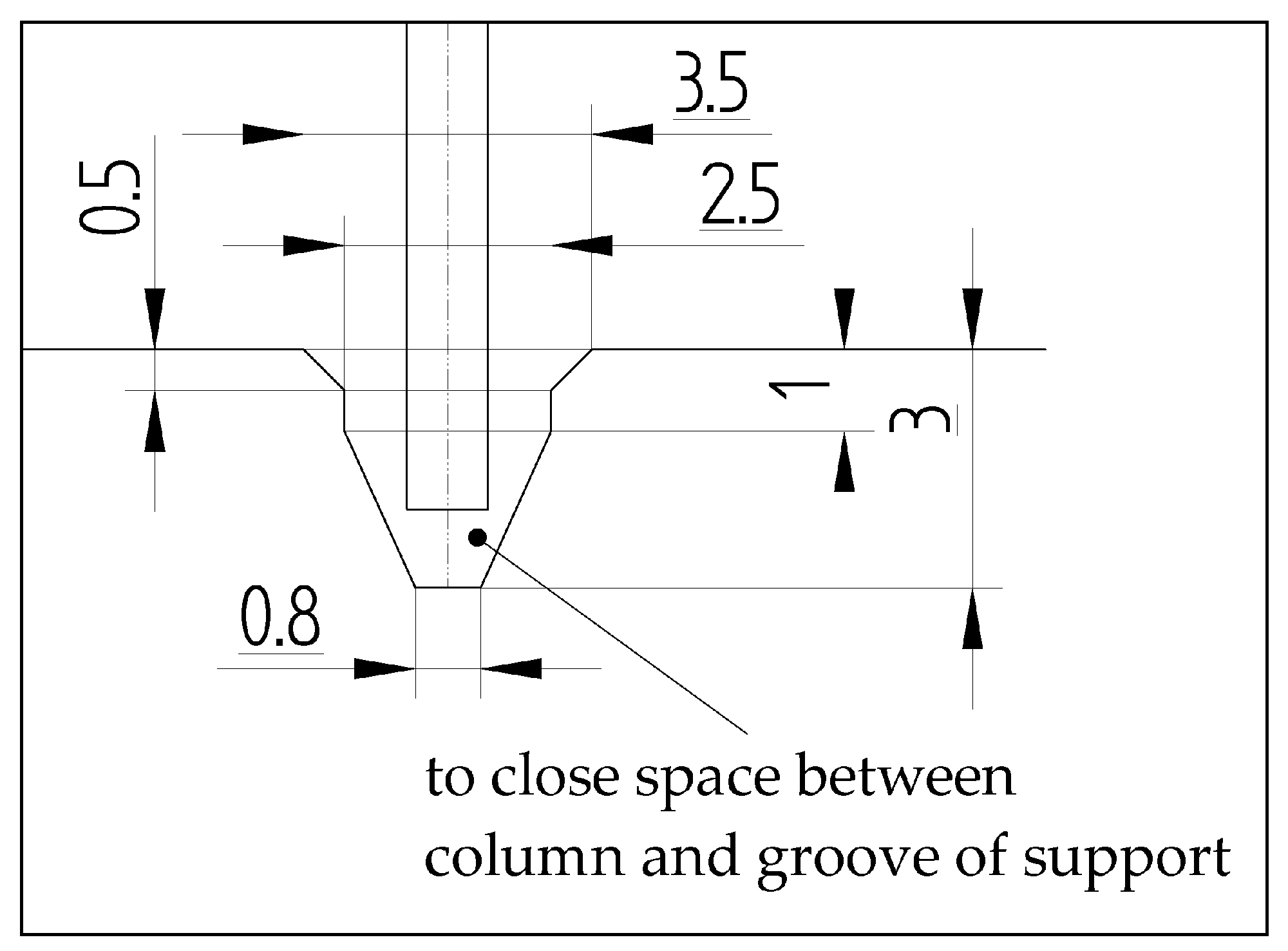
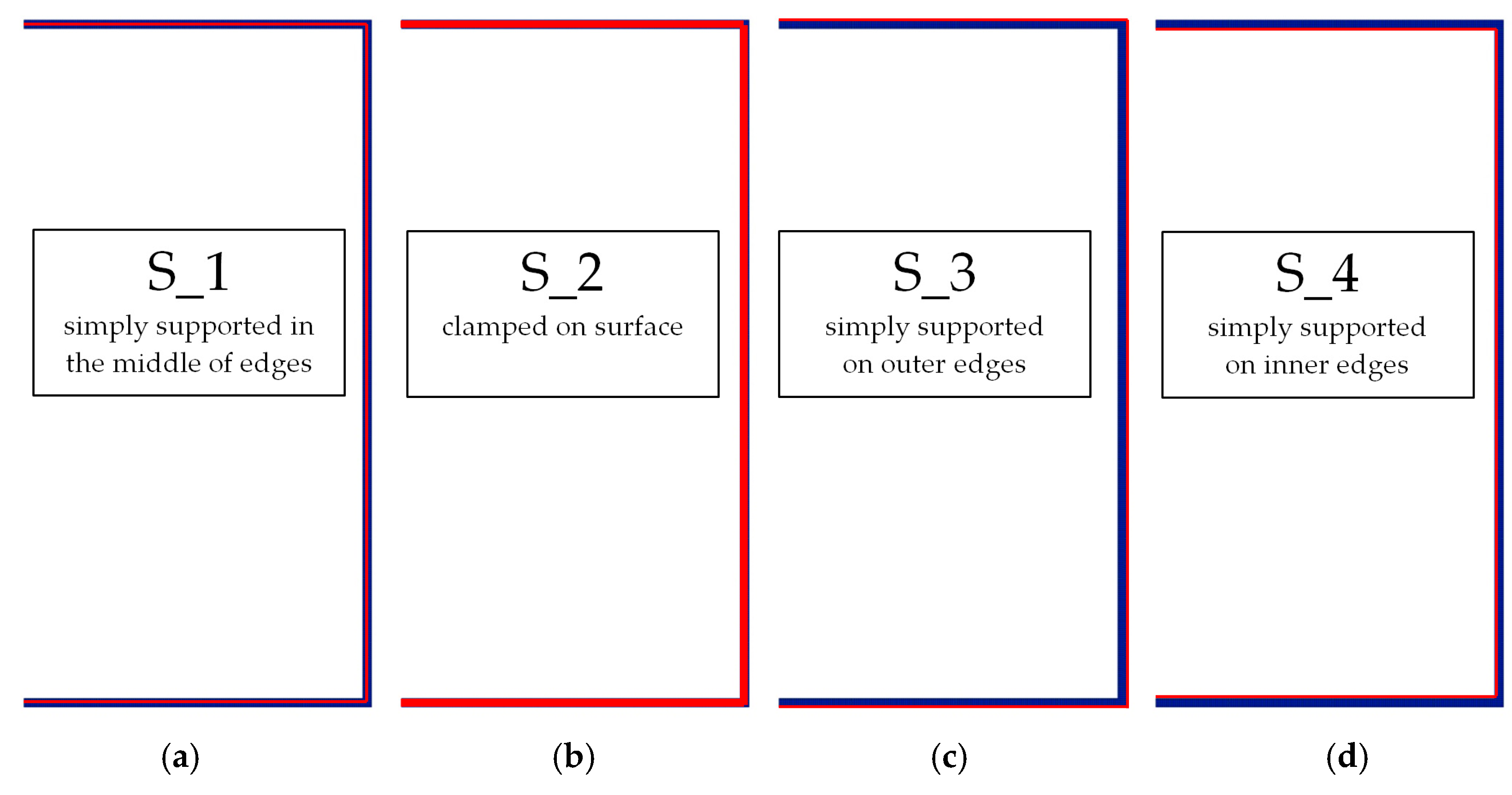

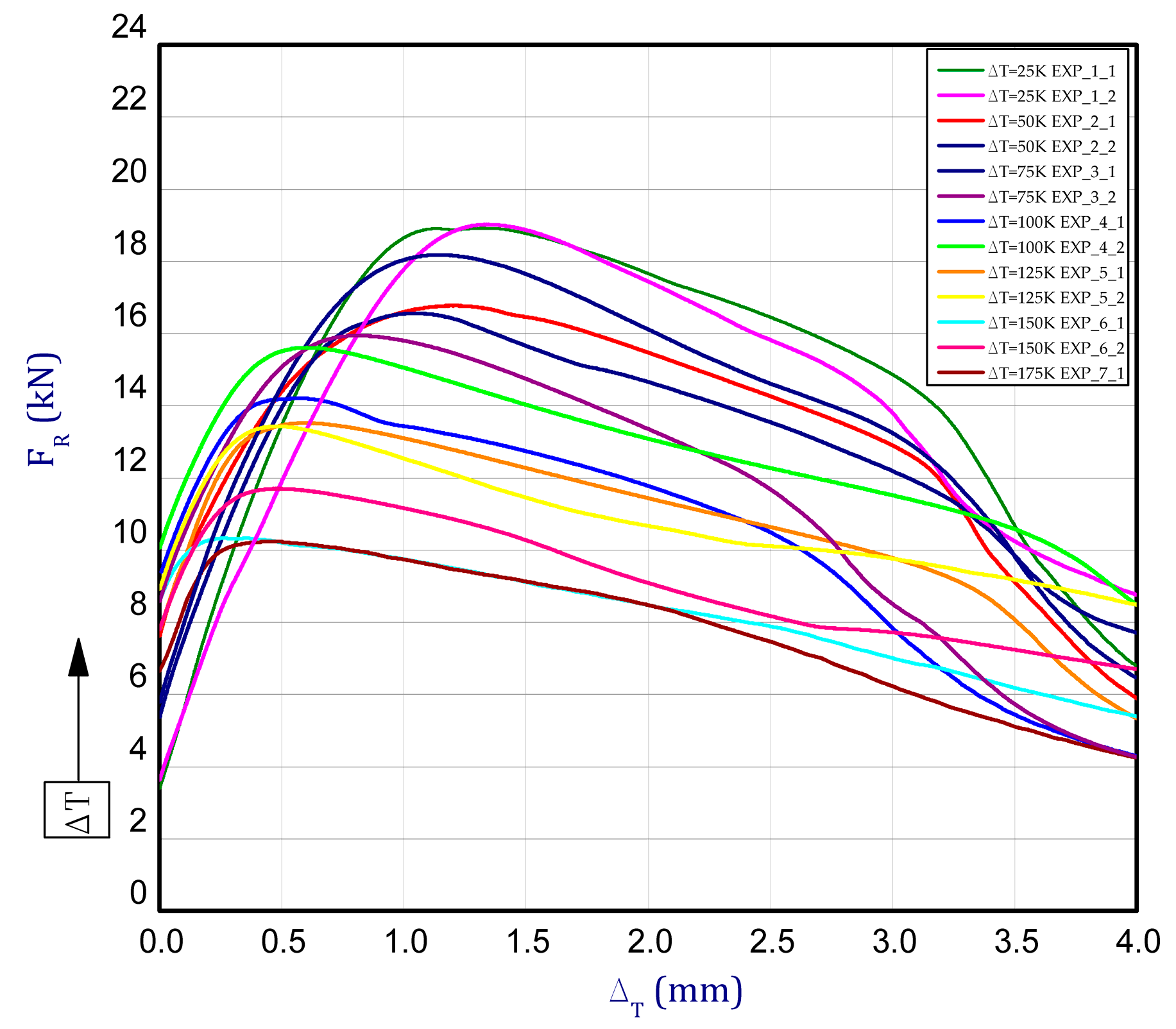
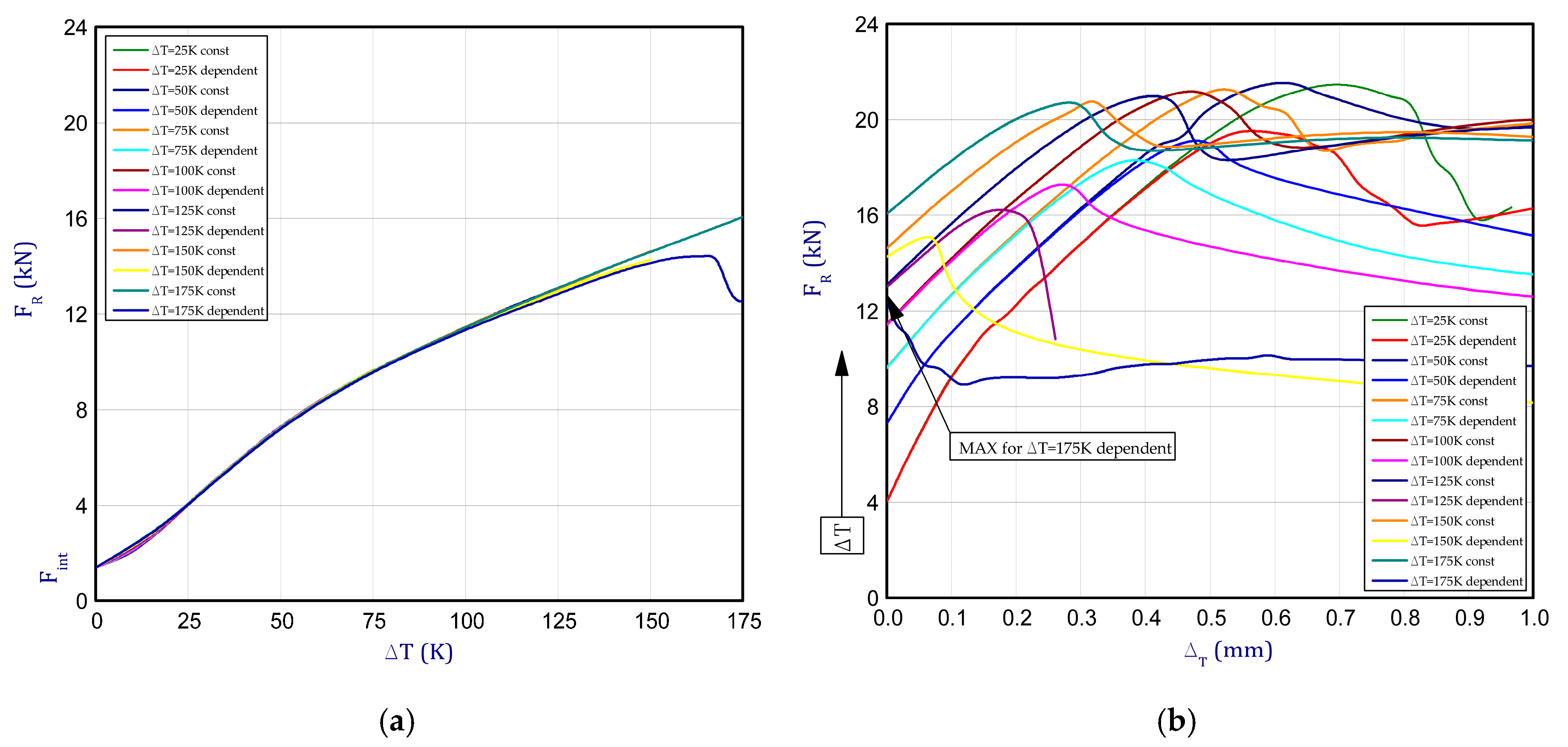
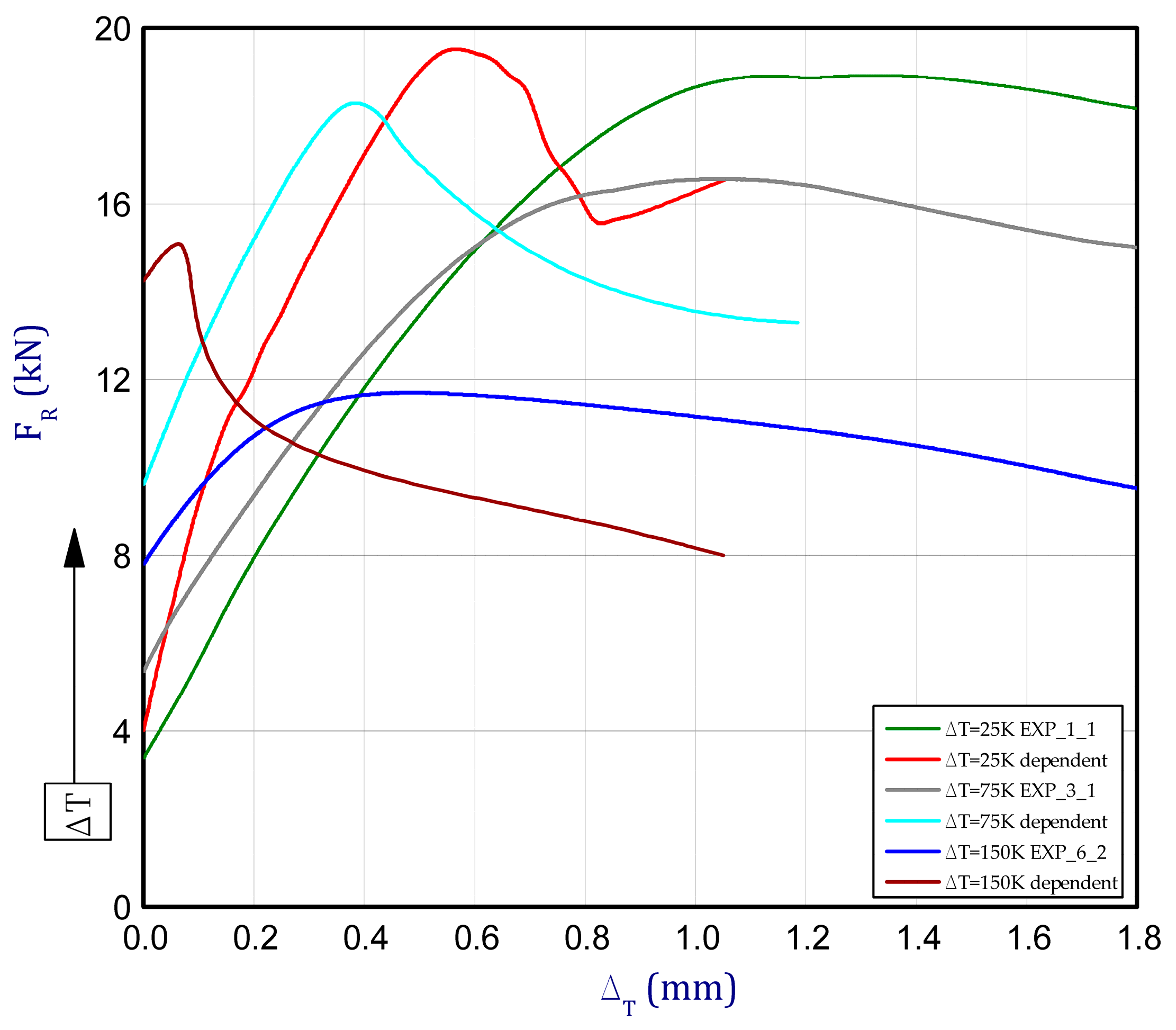
| Mode |
Temp
S_1 [K] [N] |
Temp
S_2 [K] [N] |
Temp
S_3 [K] [N] |
Temp
S_4 [K] [N] |
Comp
S_1 [N] |
Comp
S_2 [N] |
Comp
S_3 [N] |
Comp
S_4 [N] |
| 1 | 49.1 (7431.8) | 52.0 (7870.7) | 64.0 (9687.0) | 64.7 (9793.0) | 7546.8 | 8110.1 | 7807.4 | 7759.0 |
| 2 | 50.1 (7583.1) | 55.5 (8400.5) | 65.4 (9899.0) | 68.6 (10383.3) | 7774.7 | 8650.1 | 8541.3 | 8463.5 |
| 3 | 60.4 (9142.1) | 68.2 (10322.8) | 80.9 (12245.0) | 82.5 (12487.2) | 9194.2 | 10564.93 | 9969.8 | 9903.8 |
| 4 | 64.3 (9732.5) | 69.2 (10474.1) | 85.8 (12986.7) | 85.7 (12971.6) | 9850.6 | 10735.3 | 10421.1 | 10302.2 |
| 5 | 69.7 (10549.8) | 72.7 (11003.9) | 92.1 (13940.3) | 91.6 (13864.6) | 10672.0 | 11411.1 | 11643.8 | 11426.1 |
| Number of Mode | Type of Boundary Conditions | |||||||
|---|---|---|---|---|---|---|---|---|
|
Temp
S_1 |
Temp
S_2 |
Temp
S_3 |
Temp
S_4 |
Comp
S_1 |
Comp
S_2 |
Comp
S_3 |
Comp
S_4 | |
| 1 |  |  |  |  |  |  |  |  |
| 2 |  |  |  |  |  |  |  |  |
| 3 |  |  |  |  |  |  |  |  |
| 4 |  |  |  |  |  |  |  |  |
| 5 |  |  |  |  |  |  |  |  |
|
Temperature Increment [K] |
FEM Independent [kN] |
FEM Dependent [kN] | EXP |
Increase of Maximum Load (FEM-Dependent) with Regard to Experiment [%] | ||
|---|---|---|---|---|---|---|
|
Attempt 1 [kN] |
Attempt
2 [kN] |
Mean Value [kN] | ||||
| 25 | 21.5 | 19.5 | 18.9 | 19.1 | 19.0 | 2.6 |
| 50 | 21.6 | 19.2 | 16.7 | 18.1 | 17.4 | 10.3 |
| 75 | 21.4 | 18.4 | 16.5 | 16.1 | 16.3 | 12.9 |
| 100 | 21.2 | 17.4 | 14.2 | 15.6 | 14.9 | 16.8 |
| 125 | 21.0 | 16.3 | 13.5 | 13.3 | 13.4 | 21.6 |
| 150 | 20.9 | 15.2 | 10.3 | 11.7 | 11.0 | 38.2 |
| 175 | 20.8 | 12.5 | 10.2 | - | 10.2 | 22.6 |
| DT = 25 K | DT = 50 K | DT = 75 K | DT = 100 K | DT = 125 K | DT = 150 K | DT = 175 K | ||||||||
|---|---|---|---|---|---|---|---|---|---|---|---|---|---|---|
| FEM | DICAS | FEM | DICAS | FEM | DICAS | FEM | DICAS | FEM | DICAS | FEM | DICAS | FEM | DICAS | |
| 1 |  |  |  |  |  |  |  |  |  |  |  |  |  |  |
| 2 |  |  |  |  |  |  |  |  |  |  |  |  |  |  |
| 3 |  |  |  |  |  |  |  |  |  |  |  |  |  |  |
© 2020 by the authors. Licensee MDPI, Basel, Switzerland. This article is an open access article distributed under the terms and conditions of the Creative Commons Attribution (CC BY) license (http://creativecommons.org/licenses/by/4.0/).
Share and Cite
Czechowski, L.; Gliszczyński, A.; Wiącek, N. The Collapse of Titanium C-Column due to Thermal Compression. Materials 2020, 13, 4193. https://doi.org/10.3390/ma13184193
Czechowski L, Gliszczyński A, Wiącek N. The Collapse of Titanium C-Column due to Thermal Compression. Materials. 2020; 13(18):4193. https://doi.org/10.3390/ma13184193
Chicago/Turabian StyleCzechowski, Leszek, Adrian Gliszczyński, and Nina Wiącek. 2020. "The Collapse of Titanium C-Column due to Thermal Compression" Materials 13, no. 18: 4193. https://doi.org/10.3390/ma13184193
APA StyleCzechowski, L., Gliszczyński, A., & Wiącek, N. (2020). The Collapse of Titanium C-Column due to Thermal Compression. Materials, 13(18), 4193. https://doi.org/10.3390/ma13184193





